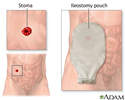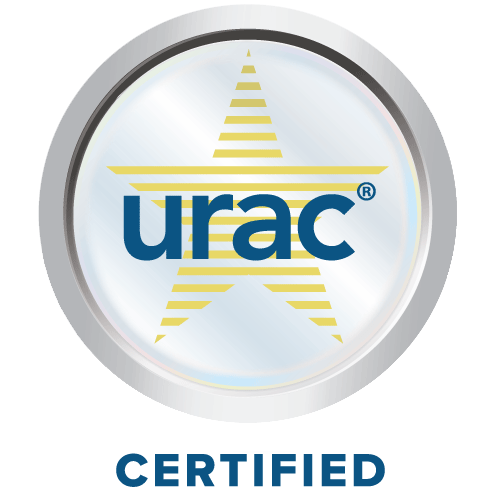Ileostomy
Enterostomy
An ileostomy is used to move waste out of the body. This surgery is done when the colon or rectum is not working properly.
The word "ileostomy" comes from the words "ileum" and "stoma." Your ileum is the lowest part of your small intestine. "Stoma" means "opening." To make an ileostomy, the surgeon makes an opening in your belly wall and brings the end of the ileum through the opening. The ileum is then attached to the skin.
Description
Before you have surgery to create an ileostomy, you may have surgery to remove all of your colon and rectum, or just part of your small intestine.
These surgeries include:
To create the ileostomy, your surgeon makes a small surgical cut in the wall of your belly. Part of your small intestine that is farthest from your stomach is brought up and used to make an opening. This is called a stoma. When you look at your stoma, you are actually looking at the lining of your intestine. It looks a lot like the inside of your cheek. An ileostomy may be used for a short or long time.
When your ileostomy is temporary, it most often means all of your large intestine was removed. However, you still have at least part of your rectum. If you have surgery on part of your large intestine, your surgeon may want the remainder of your intestine to rest for a while. You will use the ileostomy while you recover from this surgery. When you do not need it anymore, you will have another surgery. This surgery will be done to reattach the ends of the small intestine. You will no longer need the ileostomy after this.
You will need to use an ileostomy long term if all of your large intestine and rectum have been removed.
Sometimes, an ileostomy is done as the first step in forming an ileal anal reservoir (called a J-pouch).
Why the Procedure Is Performed
Ileostomy is done when problems with your large intestine can only be treated with surgery.
There are many problems that may lead to the need for this surgery. Some are:
- Inflammatory bowel disease (ulcerative colitis or Crohn disease). This is the most common reason for this surgery.
- Colon or rectal cancer
- Familial polyposis
- Birth defects that involve your intestines
- An accident that damages your intestines or another intestinal emergency
Risks
Talk with your surgeon about these possible risks and complications.
Risks of anesthesia and surgery in general are:
- Reactions to medicines
- Breathing problems
- Bleeding, blood clots
- Infections
- Heart problems
Risks of this surgery are:
- Bleeding inside your belly
- Damage to nearby organs
- Dehydration (not having enough fluid in your body) if there is a lot of watery drainage from your ileostomy
- Difficulty absorbing needed nutrients from food
- Infection, including in the lungs, urinary tract, or belly
- Poor healing of the wound in your perineum (if your rectum was removed)
- Scar tissue in your belly that causes a blockage of the small intestine (this scar tissue is often called adhesions)
- Wound breaking open
Before the Procedure
Always tell your health care providers what medicines you are taking, even medicines, supplements, or herbs you bought without a prescription.
Before your surgery, talk with your surgeon about the following things:
- Intimacy and sexuality
- Pregnancy
- Sports
- Work
During the 2 weeks before your surgery:
- Two weeks before surgery, you may be asked to stop taking medicines that make it harder for your blood to clot. These include aspirin, ibuprofen (Advil, Motrin), naproxen (Aleve, Naprosyn), and others.
- Ask your surgeon which medicines you should still take on the day of your surgery.
- If you smoke, you need to stop before the operation. Ask your provider for help.
- Always let your surgeon know about any cold, flu, fever, herpes breakout, or other illness you may have before your surgery.
The day before your surgery:
- You may be asked to drink only clear liquids such as broth, clear juice, and water after some point.
- Your surgeon will tell you when to stop eating and drinking.
- Your surgeon may ask you to use enemas or laxatives to clear out your intestines.
On the day of your surgery:
- Take the medicines you were told to take with a small sip of water.
- You will be told when to arrive at the hospital.
After the Procedure
You will be in the hospital for 3 to 7 days in most cases. You may have to stay longer if your ileostomy was an emergency operation.
You may be able to suck on ice chips on the same day as your surgery to ease your thirst. By the next day, you will probably be allowed to drink clear liquids. You will slowly add thicker fluids and then soft foods to your diet as your bowels begin to work again. You may be eating again at about 2 days after your surgery.
Outlook (Prognosis)
Most people who have an ileostomy are able to do most of the activities they were doing before their surgery. This includes most sports, travel, gardening, hiking, and other outdoor activities, and most types of work.
If you have a chronic condition, such as Crohn disease or ulcerative colitis, you may need ongoing medical treatment.
References
Galandiuk S, Netz U, Morpurgo E, Tosato SM, Abu-Freha N, Ellis CT. Colon and rectum. In: Townsend CM Jr, Beauchamp RD, Evers BM, Mattox KL, eds. Sabiston Textbook of Surgery. 21st ed. St Louis, MO: Elsevier; 2022:chap 52.
Raza A, Araghizadeh F. Ileostomies, colostomies, pouches, and anastomoses. In: Feldman M, Friedman LS, Brandt LJ, eds. Sleisenger and Fordtran's Gastrointestinal and Liver Disease. 11th ed. Philadelphia, PA: Elsevier; 2021:chap 117.
Reddy VB, Longo WE. Ileostomy. In: Yeo CJ, ed. Shackelford's Surgery of the Alimentary Tract. 8th ed. Philadelphia, PA: Elsevier; 2019:chap 84.
Review Date: 9/30/2024











